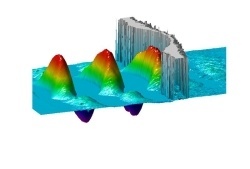Tumors under fire
Oncologists have a dream: they want to use highly energetic ion beams in good quality and accurately defined dose for a pin-sharp and cost-effective radiation treatment of tumors. Modern techniques based on intense laser pulses may in the future replace expensive conventional particle accelerators. A team of physicists of the Cluster of Excellence "Munich-Centre for Advanced Photonics" (MAP) lead by Prof. Dr. Dietrich Habs (Ludwig-Maximilian University Munich) in cooperation with scientists of the Max-Born-Institute in Berlin now succeeded to finally experimentally demonstrate a mechanism of laser-driven beam generation that has been predicted by theorists long time ago.

Illustration: Andreas Henig

Illustration: Andreas Henig
The pioneering results are published in the latest issue of Physical Review Letters.
Carbon beams are considered to be the most effective method of cancer therapy, as tumors are destroyed permanently with minimum trauma. Whereas conventional x-rays or electron beams cause significant damage to the surrounding healthy tissue on their pathway into the body, the high biological effectiveness of carbon beams can be precisely concentrated in the tumor, thus exclusively killing targeted cancer cells. Therefore, carbon ions are an outstanding tool for radiation therapy of deeply situated tumors located in highly sensitive regions like in the vicinity of the brain stem, where doctors would refuse to even contemplate surgical intervention. The generation of these beams is currently rather challenging, state-of-the-art are complex huge accelerator facilities which are extremely expensive in construction, operation and maintenance. Hence, the vast majority of today's cancer patients is unable to benefit from this kind of treatment. "As doctors we are dependent on the physicists' progress to develop a cheaper and more compact carbon beam source in order to make ion beam therapy available for everybody" Prof. Dr. Michael Molls points out, another MAP member and director of the TUM Department of Radiation Oncology.
Indeed, in recent years major advances have been achieved in the generation of highly energetic ion beams based on compact lasers instead of large-scale accelerator facilities. "The new technique allows an acceleration distance smaller than the diameter of a human hair," Habs explains. Such small distances are sufficient to accelerate ions to high energies when employing highly intense laser pulses. Not only the accelerator itself, but also the beam guide is being shrunken significantly, as the several tons of weight steering magnets can be replaced by small-sized mirrors. However, up to now no efficient method has been developed to transfer the same amount of energy from the laser to every single ion to allow for a well defined penetration depth of the particle beam in radiation therapy. This is what Prof. Habs and his team are working on. Andreas Henig carried out the first successful experiments together with Berlin physicists: "With the latest results we succeeded in an efficient ion beam generation, while simultaneously reducing the energy spread of the accelerated particles. We are very happy about this experimental break-through!"
The scientists generate the high energy ions by irradiating diamond-like carbon foils with intense laser pulses. Atoms located within the foil are split into electrons and ions by the strong electric field of the laser focus, a plasma is generated. The enormous laser intensity (about 1020 times more intense than the sun) strongly heats the electrons and separates them in an expanding cloud from the heavier and therefore slower ions. A huge charge separation field builds up, accelerating ions to velocities up to a tenth of light speed. However, up to now laser-accelerated ions exhibited a broad energy spectrum, whereas medical applications demand a well-defined particle energy to allow for a precise control of penetration depth and dose distribution in the body.
The group of Munich physicists is the first to experimentally demonstrate an acceleration process which allows all ions to fly with the same velocity. By changing the laser polarization from linear to circular and reducing the diamond-like carbon foil to only a few nanometers in thickness, an uncontrolled heating of the particles and subsequent foil expansion was avoided. Instead, the laser light now pushes the electrons collectively as a nanometer-thin layer in forward direction, dragging carbon ions with it. The whole foil is driven like a sail by the light pressure of the laser - a mechanism that has been predicted by theorists long time ago.
The accomplished results provide the first experimental proof and pave the way towards a cost-saving generation of the highly promising carbon ion beams. The next challenge for the physicists in the Cluster of Excellence is to further increase the energy of the laser-accelerated ion beam. At the moment it is not yet sufficient to penetrate the body far enough to reach deeply situated tumors. Nonetheless, Habs is excited: "Already in a few moths from now we will start irradiating single cells at our biomedical beamline here at the Max-Planck-Institute of Quantum Optics in Garching and will in parallel work hard to further enhance the parameters of the ion beam."
Original publication:
DOI: 10.1103/PhysRevLett.103.245003
14.12.2009











